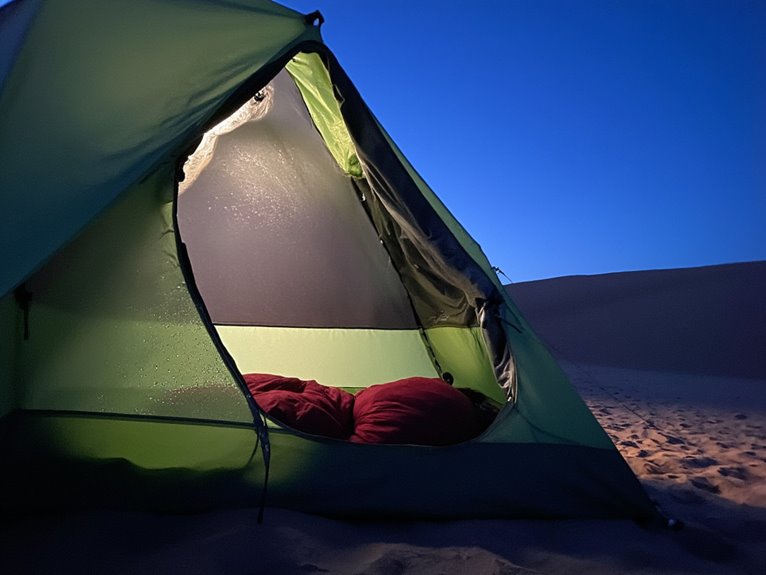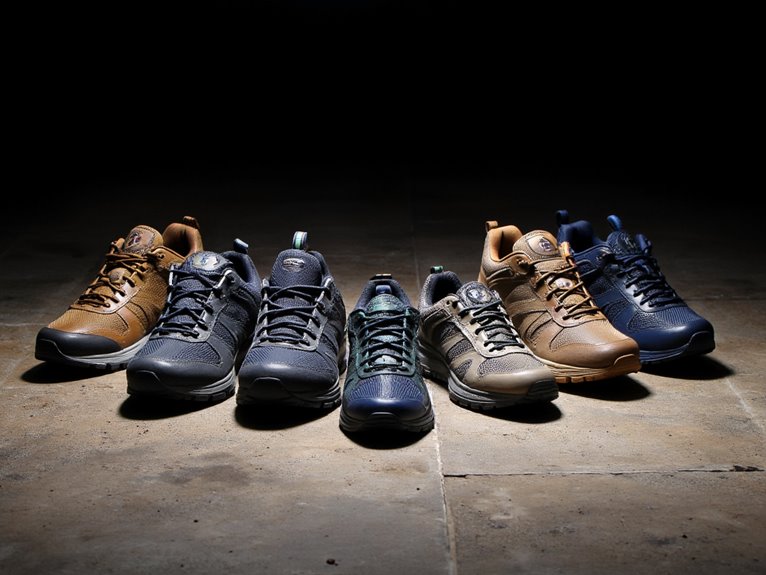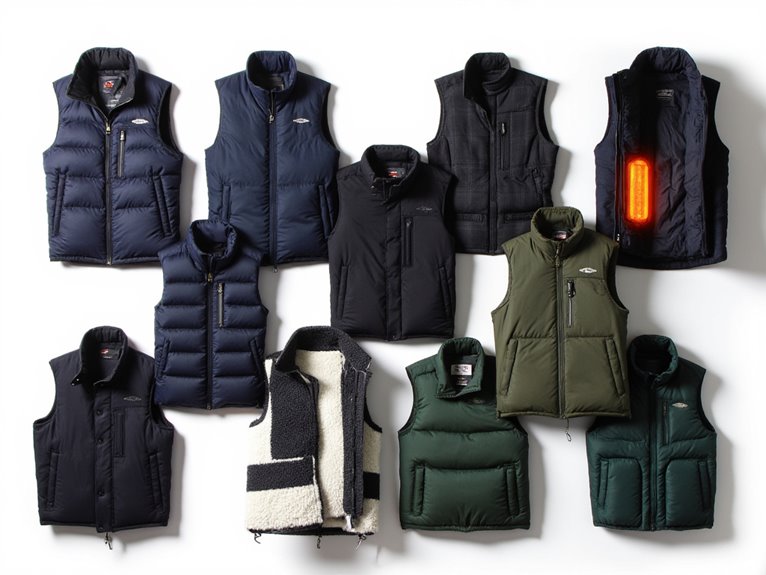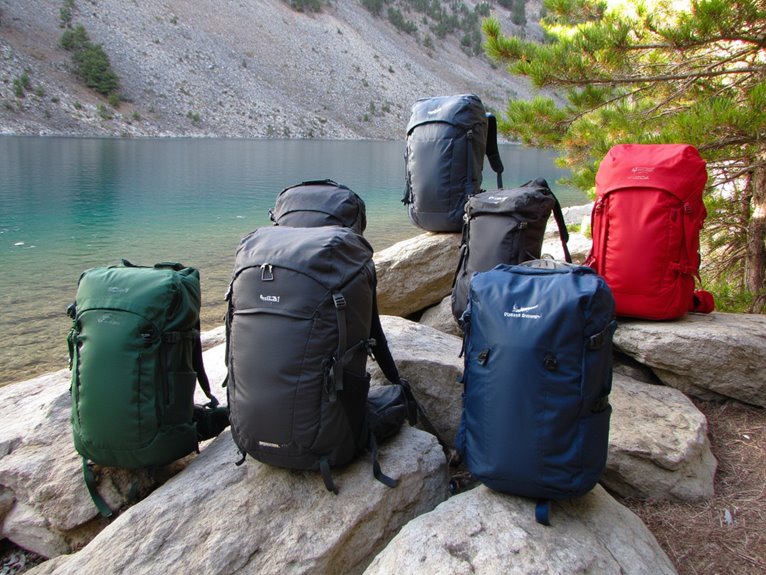Desert Camping Sleep Systems: Night Chill and Ventilation Balance
You’ll need a modular sleep system combining a patrol bag (30°F rating), ICW bag, and bivy for desert’s 42°C temperature swings. Position your tent doors toward prevailing breezes and keep all vents open for cross-ventilation while managing condensation from body heat. Layer moisture-wicking base layers with synthetic mid-layers you can quickly adjust as temperatures plummet. Choose sleeping pads with high R-values to prevent ground heat loss and synthetic insulation that retains 90% warmth when wet. Mastering these fundamentals reveals advanced desert survival strategies.
We are supported by our audience. When you purchase through links on our site, we may earn an affiliate commission, at no extra cost for you. Learn more. Last update on 10th December 2025 / Images from Amazon Product Advertising API.
Notable Insights
- Use modular sleep systems with patrol bags (30°F rating) and ICW bags for layered warmth during temperature swings up to 42°C.
- Position tent doors toward prevailing breezes and utilize all vents for cross-ventilation while managing moisture from respiration and body heat.
- Select sleeping pads with high R-values to prevent ground heat transfer and maintain insulation from cold desert surfaces.
- Employ strategic clothing layers with moisture-wicking base layers and accessible synthetic outer layers for nocturnal temperature adjustments.
- Choose elevated campsites and regularly wipe tent walls to control condensation while keeping vents partially open for airflow.
Understanding Desert Temperature Extremes and Their Impact on Sleep
When you’re planning a desert camping trip, understanding temperature extremes becomes critical for your sleep quality and safety.
Desert temperatures can reach 56.7°C (134.1°F) during the day, then plummet to -4°C (25°F) at night. This 42°C temperature swing occurs because clear desert skies allow rapid heat loss through radiation.
Desert nights can drop to freezing after scorching days, creating extreme temperature swings that challenge even experienced campers.
Low humidity compounds this effect, enabling faster temperature changes that disrupt your sleep patterns.
Desert wildlife has developed thermal adaptation strategies you can learn from. Animals create microclimates and adjust their behavior to survive these extremes.
Your sleep system must account for similar challenges. Inadequate insulation leaves you vulnerable when temperatures drop sharply after sunset. Poor ventilation traps heat and creates condensation issues.
You’ll need equipment that handles both extremes while maintaining comfort throughout the night. In these conditions, synthetic insulation often outperforms down because it retains warmth when exposed to moisture and dries faster during temperature fluctuations.
Strategic Layering Systems for Variable Night Temperatures
Your sleep system’s success in desert environments depends on creating modular clothing layers that respond instantly to temperature swings of 40°F or more between sunset and dawn.
You’ll need base layers for moisture management, insulating mid-layers for heat retention, and protective outer shells with ventilation options that work together as one integrated system.
Mastering quick adjustment techniques—like partial zippers, removable layers, and strategic ventilation—allows you to fine-tune your body temperature without fully disrupting your sleep cycle.
Modular Sleep System Components
Strategic layering forms the foundation of effective desert sleep systems, where nighttime temperatures can plummet 40 degrees or more from daytime highs. The modular advantages of systems like the Improved Modular Sleep System (IMSS) provide critical system adaptability for extreme temperature swings.
The IMSS consists of three primary components that offer versatile configuration options:
- Patrol Sleeping Bag – Rated to 30°F with 40°F comfort rating for moderate conditions
- Intermediate Cold Weather (ICW) Bag – Combines with patrol bag for enhanced cold protection
- Bivy Bag – Delivers waterproof and windproof protection using durable materials like Goretex
You’ll benefit from synthetic insulation like Climashield, which maintains thermal efficiency when moisture is present.
Two included stuff sacks enable organized packing while component interchangeability allows separate or combined use based on conditions.
Temperature-Responsive Clothing Layers
While modular sleep systems provide your primary thermal protection, strategic clothing layers serve as the critical first line of defense against desert temperature swings that can drop from 90°F to 50°F within hours.
Your layer composition begins with a moisture-wicking base layer—Merino wool or synthetic blends that pull sweat from skin. Merino wool offers natural odor resistance for multi-day trips, while synthetics provide quick-drying performance at lower cost.
Add fleece or synthetic insulation as your middle layer. Down provides superior warmth-to-weight ratios but loses efficiency when wet.
Your outer shell blocks wind and prevents conductive heat loss while maintaining breathability. Effective moisture management requires quick-drying materials that prevent prolonged chill from residual sweat.
Size layers with room for airflow—tight fits reduce insulation effectiveness and restrict circulation.
Quick Adjustment Techniques
Because desert temperatures can plummet 40°F in a matter of hours, you’ll need a modular sleep system that allows rapid adjustments throughout the night.
Sleep system flexibility becomes critical when temperatures drop from comfortable evening conditions to near-freezing before dawn.
Your night temperature strategies should include these core techniques:
- Layer stacking: Combine closed-cell foam pads with air mattresses to boost R-values from 3.5 to 7+ instantly.
- Quilt combination: Stack lightweight quilts using adapters to prevent draft gaps and maintain alignment.
- Zoned management: Add extra insulation at feet and head zones where heat loss concentrates.
Keep synthetic outer layers accessible for condensation control.
Position down insulation as your core warmth provider.
Practice nocturnal adjustments before your trip—you’ll need to add or remove layers without exiting your system.
Sleeping Bag and Pad Selection for Four-Season Desert Conditions
Your sleeping bag and pad selection forms the foundation of your four-season desert sleep system, requiring careful consideration of temperature ratings, insulation properties, and thermal efficiency.
Four-season bags must handle extreme temperature swings from scorching days to near-freezing nights, while your pad’s R-value determines how effectively it’ll block ground heat transfer in both summer and winter conditions.
The choice between down and synthetic fill materials directly impacts your system’s performance in desert humidity, weight requirements, and temperature regulation capabilities.
Carrying a repair kit with fabric patches and outdoor-grade adhesives ensures you can address small punctures and tears that may occur from desert terrain’s sharp rocks and thorny vegetation.
Four-Season Bag Essentials
Desert nights demand serious insulation when temperatures plummet below -5°C, making four-season sleeping bags essential gear for high-altitude camping and winter desert expeditions.
These bags prioritize warmth through specialized four season bag features like box wall construction and vertical baffles that eliminate cold spots.
Key insulation types include:
- 800-fill down – Superior warmth-to-weight ratio, packs smaller but requires moisture protection
- Synthetic fill – Maintains warmth when wet but weighs more and compresses less efficiently
- Heavy-duty insulation – Enhanced warmth for extreme conditions, though bags exceed 3kg
Draft collars and insulated hoods minimize heat loss while allowing controlled ventilation.
You’ll need proper sleeping pad insulation to prevent ground heat transfer.
Weight varies from ultralight 850-gram down bags to budget-friendly 3kg+ synthetic options.
R-Value Insulation Requirements
While your four-season bag provides the primary thermal barrier, its performance depends heavily on the R-value ratings of both your sleeping bag and pad working together as an integrated system.
Desert camping requires specific R value standards based on seasonal conditions. Summer nights typically need 1-2 R-value, while winter demands 6+ R-value for adequate thermal protection. Your sleeping pad should maintain at least 4.0 R-value for colder desert conditions to maximize bag efficiency.
Insulation materials greatly impact performance characteristics. Down fill offers superior warmth-to-weight ratios but loses effectiveness when wet. Synthetic fills maintain insulation properties in moisture but weigh more.
Desert temperature fluctuations require balancing these materials with ventilation features like mesh panels or breathable fabrics to prevent overheating while maintaining necessary thermal protection during night chill periods.
Down Versus Synthetic Fill
The battle between down and synthetic insulation becomes critical when selecting gear that must perform across desert’s extreme seasonal variations.
You’ll face temperature swings from 100°F days to 20°F nights, demanding insulation that adapts efficiently.
Down insulation benefits include superior warmth-to-weight ratios and exceptional compressibility. High-quality 900fp down provides maximum insulation per ounce while packing smaller than synthetic alternatives.
However, synthetic insulation drawbacks become apparent in desert moisture scenarios where unexpected humidity renders down useless.
Consider these key performance factors:
- Moisture tolerance – Synthetic maintains 90% insulation when wet versus down’s 10%
- Pack volume – Down compresses 40% smaller than equivalent synthetic fill
- Temperature range – Down performs better in extreme cold below 15°F
Your choice depends on seasonal timing and moisture expectations in your target desert region.
Managing Condensation and Airflow in Arid Environments
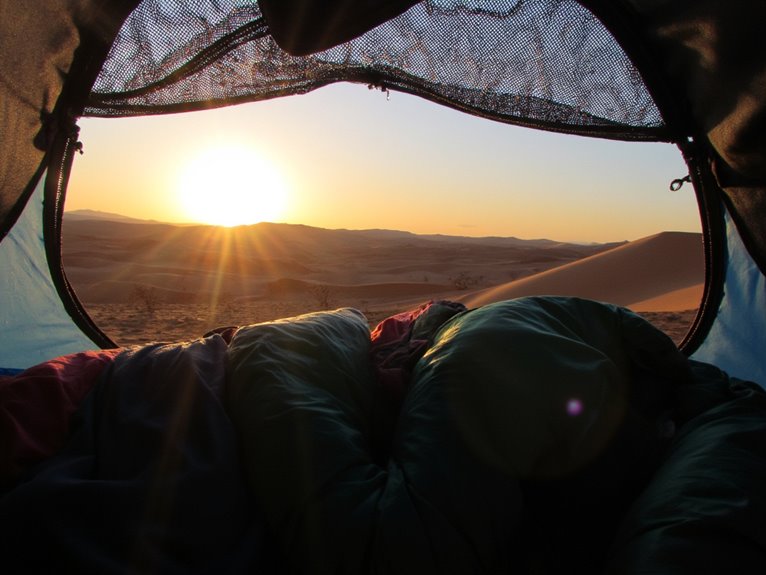
Although desert environments seem inherently dry, condensation can still pose significant challenges to your sleep system’s performance and comfort. Moisture accumulates from respiration and body heat, creating problematic dampness inside your shelter.
Effective ventilation techniques require strategic positioning of your tent’s airflow systems. Open all vents and windows to establish cross-ventilation patterns. Position your door toward prevailing breezes and guarantee gear doesn’t obstruct airflow paths. Mesh panels enhance circulation without compromising protection.
Proper condensation management involves multiple approaches. Wipe down tent walls regularly to remove accumulated moisture. Use breathable tent fabrics and groundsheets to prevent ground moisture infiltration.
Choose elevated campsites with natural airflow, avoiding low-lying areas where humidity concentrates. Monitor weather forecasts for humidity changes that could affect your sleep system’s thermal efficiency. Position your sleeping pad on compact soil rather than loose sand to ensure stable placement and prevent heat transfer to the ground.
Physiological Factors Affecting Sleep Quality in Cold Desert Nights
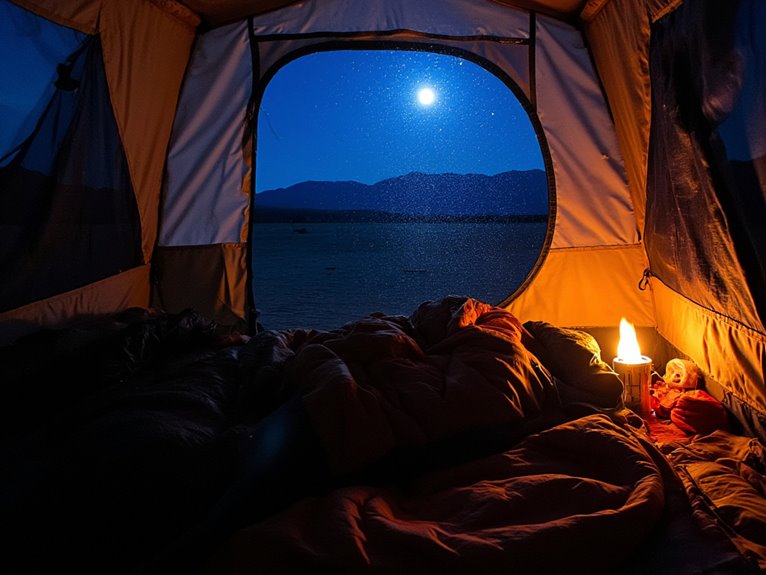
When temperature drops considerably in desert environments after sunset, your body initiates a complex series of physiological responses that directly impact sleep quality and duration.
Cold exposure triggers increased norepinephrine production, elevating alertness levels that can delay sleep onset. Your core temperature naturally decreases with cooler ambient conditions, signaling rest phases.
Cold exposure increases norepinephrine levels, heightening alertness and delaying sleep onset despite the core temperature drop that typically signals rest.
Three critical physiological factors affect your desert sleep:
- Hormonal fluctuations – Melatonin production increases with prolonged darkness, while cortisol levels shift due to cold stress.
- Circadian rhythm disruption – Temperature variations and reduced sunlight exposure alter your natural sleep-wake cycle.
- Respiratory challenges – Dry air exacerbates breathing difficulties, potentially worsening snoring or sleep apnea.
Maintaining proper sleep hygiene becomes essential when managing these physiological changes in cold desert conditions. Understanding temperature ratings for your sleep system helps ensure you select appropriate insulation levels that work with rather than against your body’s natural thermal regulation processes.
Modular Sleep System Components for Rapid Temperature Adaptation
Flexibility becomes paramount when desert temperatures plummet from scorching daytime highs to near-freezing lows within hours. You’ll need a modular system that adapts quickly to these dramatic shifts. Sleeping bag layering forms your core strategy—combine lightweight and heavyweight bags for temperature ranges from 20°F to 70°F. Your sleeping pad provides ground insulation with R-values of 1.0 for summer conditions. Bivy sack essentials include Gore-Tex construction for wind protection and heat retention.
| Component | Temperature Range | Weight |
|---|---|---|
| Lightweight Bag | 45-70°F | 1-2 lbs |
| Heavy Bag | 20-45°F | 3-4 lbs |
| Bivy Sack | All conditions | 1-2 lbs |
Add liners for 5-15°F extra warmth and moisture control. This system lets you shed or add layers rapidly. For optimal weight distribution, prioritize bags with compression sacks that reduce packed size by up to 40% to water bottle dimensions.
Protecting Gear and Optimizing Comfort in Harsh Desert Terrain
Building a modular sleep system represents only half the battle in desert environments—your gear faces constant assault from abrasive terrain, temperature extremes, and invasive particles that can destroy equipment and compromise comfort within hours.
Effective gear maintenance requires three critical protection strategies:
- Ground barriers – Deploy puncture-resistant groundsheets made from reinforced nylon to shield tent floors from sharp rocks and thorny vegetation.
- Particle exclusion – Store footwear in sealed bags and use pack liners to prevent sand infiltration into sensitive equipment.
- Thermal management – Position light-colored tents with open vents during daylight hours to promote airflow and reduce heat accumulation.
Climate adaptation demands systematic protection protocols. Sweep campsites clear of debris before setup. Use protective tarps for external gear storage.
Maintain daily tent cleaning routines to prevent grit accumulation that degrades zippers and fabric integrity. Desert camping requires specialized sleeping pads with durable surface materials that resist punctures from sharp rocks and thorny desert vegetation.

